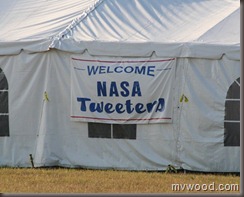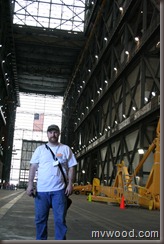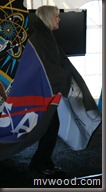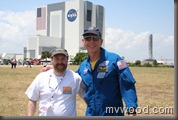Looking Beyond the Clouds: Part 1
First off, let me say that this blog post is not technical in nature. If you are reading my blog because of my interest in Windows Azure I’ll warn you now I’m not going to talk about Cloud Computing in this post, but instead I’m going to talk about something else I’m passionate about .
.
For those of you who don’t follow me on Twitter (@mikewo) you have missed out on the fact that I was in Florida for a few days attending what’s known as a NASA Tweetup. 150 people were selected to attend the STS-134, Endeavor space shuttle launch on April 29th as well as a day of great content on the 28th. Both days were were at the  NASA Press site, which is only a little over three miles from the launch pad. While the shuttle may not have taken off, I certainly was treated to an unbelievable experience.
NASA Press site, which is only a little over three miles from the launch pad. While the shuttle may not have taken off, I certainly was treated to an unbelievable experience.
You can read about what we did from other participants, and from one of the organizers, Beth Beck (Day One, Day two). What I want to talk about is what I really got out of the event, which was way more than could have ever been described in an agenda.
What I Learned:
I learned that while even though I’m in my mid-thirties all you need to do to make me a kid again is put me in front some astronauts. Astronauts are heroes, plain and simple. They are people willing to put their life on the line to make sure that mankind go beyond the boundaries of Earth. I met three astronauts during this event. Each handshake and pictures I have with them will be a lifelong memory for me. Whether you agree with the space program or not, you should have no problem respecting the amount of work and risk these men and women have put forth to push our space exploration efforts forward.
I learned that there are so many programs and opportunities for kids to learn that I wish were around when I was a kid. It sounds silly, but some of the cargo on the Endeavour flight STS-134 bound for the International Space Station includes Golden Orb spiders, fruit flies and a bunch of LEGOs. They are going to study how the spider spins its web in micro-gravity. Classrooms around the country can also get their own spiders so that they could compare the webs of their own spiders with that of the one living on the space station. The fruit flies are actually being sent along as food for the spiders, but why waste resources? They plan on using them to study how flies move in microgravity as well. The LEGOs (check out legospace.com) are going to be used to show students how gravity applies stress and force on objects. Once of the models being sent would normally take 3-4 people to assemble on the ground, but with a little help _thumb.jpg) from zero-G and no stress on the long extensions an astronaut will be able to assemble a model of the ISS easily in space. (On a side note, I also learned that there is actually a job called LEGO Designer which must be the second best job on the planet… after astronaut, of course).
from zero-G and no stress on the long extensions an astronaut will be able to assemble a model of the ISS easily in space. (On a side note, I also learned that there is actually a job called LEGO Designer which must be the second best job on the planet… after astronaut, of course).
In addition to the spidernaut and toys headed up the ISS there are also canisters of bacteria that will be studied. It seems that when some bacteria gets into orbit it becomes very aggressive and grows much faster than here on Earth. Studying this may lead to better medicines. There are tons of experiments going on every day aboard the ISS and in the shuttles when they go up. These experiments and the scientific data produced from them give us great advances here on Earth. We’ve learned ways of detecting and help fighting cancer through space technology. We’ve learned how to detect smoke and carbon monoxide because it needed to be detected on Skylab. Those are just a fraction of the everyday technologies in use on Earth today because of space exploration.
very aggressive and grows much faster than here on Earth. Studying this may lead to better medicines. There are tons of experiments going on every day aboard the ISS and in the shuttles when they go up. These experiments and the scientific data produced from them give us great advances here on Earth. We’ve learned ways of detecting and help fighting cancer through space technology. We’ve learned how to detect smoke and carbon monoxide because it needed to be detected on Skylab. Those are just a fraction of the everyday technologies in use on Earth today because of space exploration.
If you’re a teacher, or a parent that wants their kids involved, reach out to the NASA Education department and learn how you can bring these science experiments to your students. I know I’ll be showing my son the videos of the spiders and more.
I learned that even NASA understands that fostering the arts leads to creativity and problem solving skills. There have been musical instruments on the ISS, including a guitar and a keyboard. Not only is this something the astronauts can do to help unwind during their off hours, but as astronaut Leland Melvin mentioned the creativity of music helps develop creative thinking. When you’re in space you have to think on your feet and come up with creative ideas on how to handle problems, experiments and tasks. If one of the leading scientific organizations on our planet realizes the benefits of the arts for creative thinking, how is it that we are allowing our education system to discontinue music and art programs? Is it because they don’t have the budget? Or is it because we as a country don’t see the benefits of creative programs bring our children? If we did, perhaps we would be fighting harder to keep these programs. Math, science and history are all extremely important, but creative thinking is what will allow our children to take those other skills and apply them to solve the problems of tomorrow.
***I learned that ***people with passion for space exploration come from a very diverse set of backgrounds. At the event I met a decent amount of people who were in Engineering or software development (including several developers for Twitter itself), basically, the type of geeky people you’d expect to find at a space event. But, there were also teachers, authors, belly dancers (okay, just one of those), sales people, retired people and even actors. We all shared one thing: awe of the space program and the achievements of space exploration.
 There was a point where I was standing inside the Vehicle Assembly Building looking around me at the sheer magnitude of the size of that building and what it has enabled us to do. I know I had a big smile on my face because I felt like I was a little kid in the best candy store ever. I was looking around me and caught the eye of Seth Green (@SethGreen). He also had the same exact grin on his face and I could tell that he was as much wrapped up in all of this as I was. Really, I saw the same giddiness on almost every face I looked at.
There was a point where I was standing inside the Vehicle Assembly Building looking around me at the sheer magnitude of the size of that building and what it has enabled us to do. I know I had a big smile on my face because I felt like I was a little kid in the best candy store ever. I was looking around me and caught the eye of Seth Green (@SethGreen). He also had the same exact grin on his face and I could tell that he was as much wrapped up in all of this as I was. Really, I saw the same giddiness on almost every face I looked at.
I learned that sadly I believe the majority of this country has lost sight of what space exploration means. In the sixties during the space race the nation was almost completely unified on getting to the moon; Beat the Russians; Fulfill the dream of a young President. Now days it seems the imagination of the nation is not in the stars like it once was. In fact, I’m not sure I can even say that anything captures the imagination of the nation as a whole anymore; a very sobering thing. We are a nation of explorers and entrepreneurs, or at least we once were. Where is that drive now?
I recognize that space travel is expensive and dangerous. I recognize that these days this nation is bleeding money into an ever-growing chasm of debt, but space exploration isn’t the same as a lot of the programs we spend money on. Quite frankly, in my opinion, it is the future of our species. Take a look at the growth of population worldwide. Couple that growth with the fact that we are all living longer as medical science continues to provide us ways of extending our lives and you should quickly realize that we are running out space and resources here on our planet. Politian’s yell about correcting the debt problem for our children. I say that yes, we do need to do something about the debt problem, but we also need to continue to fund space exploration so that our children can go beyond our planet to find resources to sustain us.
The Chief Scientist of NASA, Waleed Abdalati, made an awesome statement during his presentation to us. He was answering a question from a teacher about what to tell their students. He said, “tell them that the future is theirs for the creating”. He specifically said, not for the taking, but the creating. This statement resonated again with me when Leland Melvin mentioned the creative nature of music and arts. It resonated with me when they were telling us about the experiments they are doing in space, especially those that are linking in students on the grounds. This statement just resonates with me as a father.
My five year old son has already said he wants to be scientist (he also wants to be a flashlight, but I’m not sure how to encourage that…). He also cried when I told him I was going on a trip to watch the shuttle launch, but that he couldn’t come with me. He wanted to see the shuttle launch just as much as I did. While I was on my trip my wife told him that astronauts are scientists and he was really excited to hear that. He wants to go to space and I know I’m going to be helping him find creative ways to get there if that’s what he wants to do.
Thank you …
_thumb.jpg)
 I wanted to say THANK YOU to NASA for having us Tweeters out for the event. It is a life long memory I will have of the closest that I can come to being in space for now. Especially I’d like to thank Beth Beck (@BethBeck), Stephanie Schierholz (@schierholz) and John Yembrick (@yembrick). These three were our hosts and organizers at the Tweetup and somewhat like superheroes to all of us at the event.
I wanted to say THANK YOU to NASA for having us Tweeters out for the event. It is a life long memory I will have of the closest that I can come to being in space for now. Especially I’d like to thank Beth Beck (@BethBeck), Stephanie Schierholz (@schierholz) and John Yembrick (@yembrick). These three were our hosts and organizers at the Tweetup and somewhat like superheroes to all of us at the event.
Perhaps one day before I pass on they will have commercial travel (ahem….I should say affordable as well) to space. If so, I’m so signing up for one of those trips.
Oh, you may be wondering why this is entitled Part 1… I guess we’ll see.

_thumb.jpg)
_thumb_2.jpg)